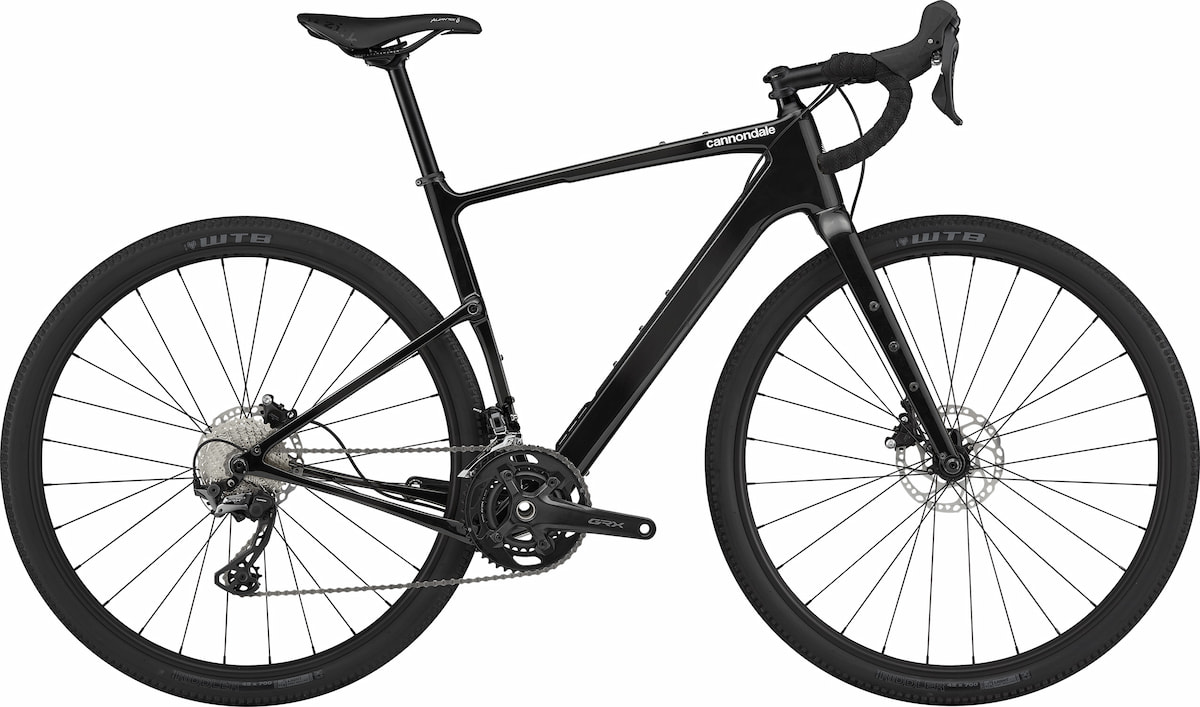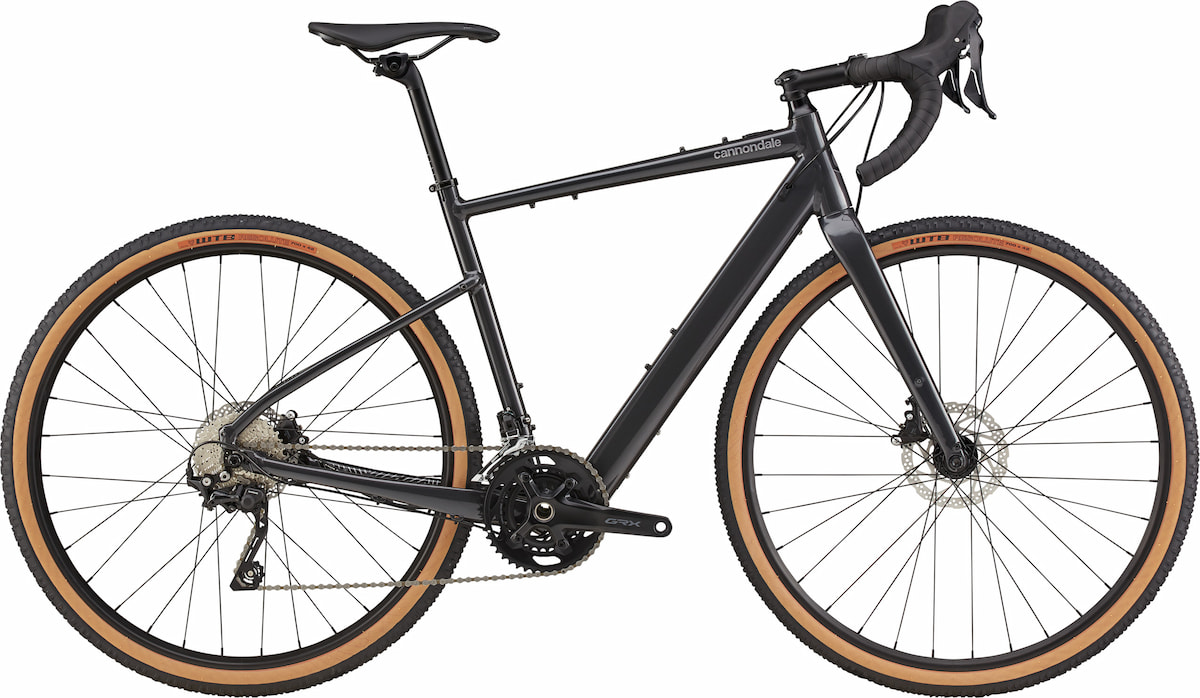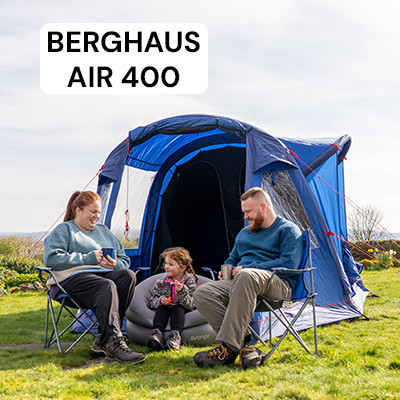
Cannondale Topstone Buyers' Guide
This is the definitive guide to Cannondale’s gravel bike range. "Topstone" is the name that Cannondale give to their off-road, road bikes. For those who are making their first foray into the discipline, gravel bikes lie somewhere between dedicated road bikes and hardtail mountain bikes. They are designed to be ridden both on tarmac and dirt and come equipped with drop bars, mid-width tyres, and gearing somewhere between mountain and road ratios. They’re designed to cope with rough terrain and singletrack but still be fast on smoother gravel and tarmac surfaces. This makes them incredibly versatile machines and ideal for heading out on adventures where you expect to encounter a variety of terrain.
The Cannondale Topstone is a real classic of the gravel genre and the whole range has seen many exciting updates over the seasons. Where these bikes shine is in their adaptability. Every bike in the range is highly capable and versatile but each model has its own bias towards a particular use. They can be split into three main categories: aluminium (alloy) framed, carbon framed and electric. Read on to learn about the collection, so you can choose the best bike for your needs.


Alloy Topstones
The alloy Topstones represent the best value in the collection because it is more economical to manufacture frames from aluminium than carbon fibre. Much of the cost of the bike is in the frame, so you can save yourself quite a few pennies by opting for aluminium. The disadvantages are a small weight penalty and a slightly harsher ride feel with more “trail buzz”. The latter is well mitigated by Cannondale’s use of dropped chainstays on the new season bikes. This gives more flex in the rear triangle for a more vertically compliant back end. You can think of this as having very short travel rear suspension. One important feature to note is that all bikes in the range (barring the lefty bike, but more on that later) have a carbon fork, which reduces feedback and the aforementioned “trail buzz” from the front wheel, as well as being lighter than an alloy alternative.
Other updates from previous years included increased tyre clearance from 42mm to 45mm for 700c wheels. You can squeeze in even wider rubber if you fit a 650B wheelset. However, Cannondale has not published tyre clearance numbers for 650B, so do this with a degree of caution. There are also new cable ports for internally routed dropper post cables.
Next is the addition of even more mounting points. Bikepackers rejoice! The Topstone has always had plenty of water bottle bosses alongside pannier rack and mudguard compatibility, as should be expected. Other carry-overs include toptube bolts for fitting bags more securely and under-the-downtube bolts for an extra water bottle or tools by the bottom bracket. The forks have triple bolts down each leg for fitting gear cages. This adds a lot of potential carrying capacity, without any trade-offs, massively enhancing the Topstones bikepackability.
With that said, let's dive into the individual model specs...
Confusingly, the bigger the number, the lower the spec. So, the Topstone 4 represents the entry-level bike but that doesn’t mean it’s not highly capable. In fact, it is astoundingly good value and off-road ready from the get-go. Working from the bottom up, as with all the alloy bikes, the 4 comes equipped with 37mm WTB Riddler Tyres. These are great for fast rolling on tarmac and smooth gravel, as can often be found on bike paths or forestry roads. You can also mount mudguards straight away with tyres of this width, which you couldn’t do if you were pushing the limits of clearance. However, if you’re going to be spending a lot more time off road than on road, it may be worth switching up to some chunkier rubber for better grip and bump absorption at the expense of rolling resistance and mudguard compatibility.
The drivetrain comes in the form of Microshift’s Advent X 1x10 mountain bike groupset. While it isn’t quite so polished as the likes of Shimano or SRAM kit, it is functionally excellent. You’ll struggle to find any other bike at this price point with a clutch rear mech. The combination of clutch derailleur and narrow-wide front chainring makes for excellent chain security and minimal chain slap. This alone makes the Topstone 4 an excellent choice if you are looking for your first gravel bike to go adventuring with and you’re on a bit of a budget. It is a dependable bike you can take into the back of beyond and use on rough terrain.
There are two main sacrifices made to bring the 4 to such an attainable price point. The first is the speccing of Promax cable brakes, which aren’t so adjustable as more sophisticated cable options and nor do they offer the same power and modulation as hydraulics. Secondly, the wheelset is relatively basic and not tubeless compatible. However, crucially, the hubs do use sealed cartridge bearings for ease of maintenance, long life, and weatherproofing.
Topstone 3
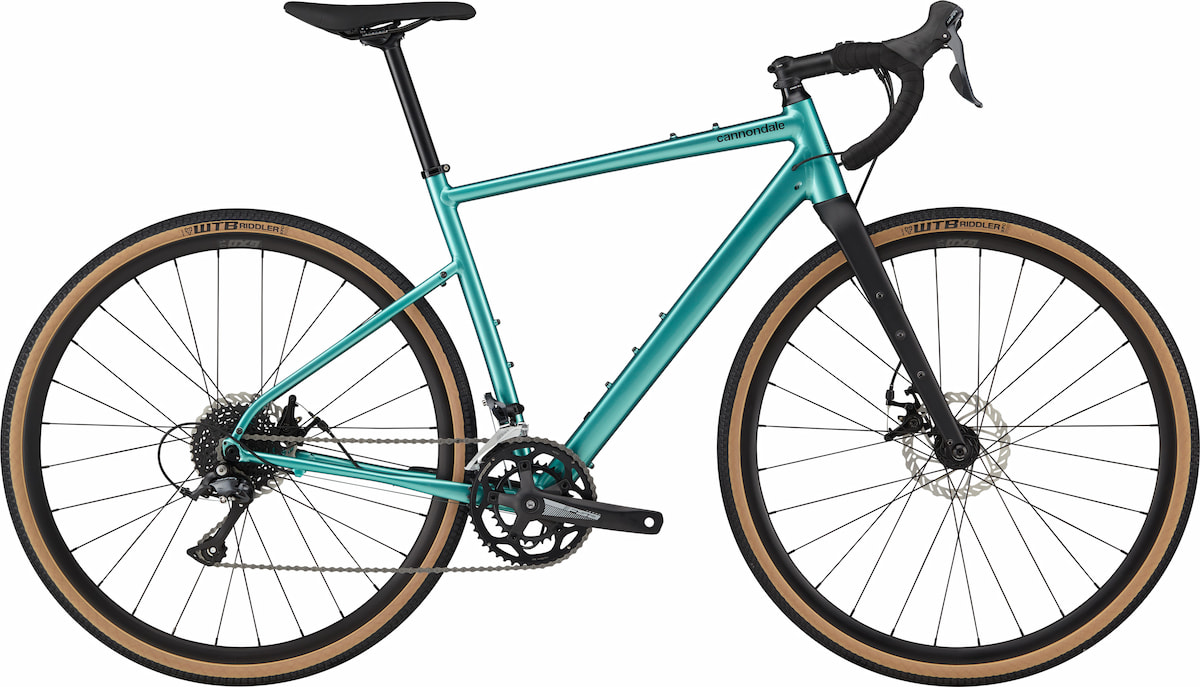

Not a great deal changes between the 3 and 4 models but what does change has a big impact on what the 3 is suitable for. The major difference is in the drivetrain where the 1x10 Microshift groupset is switched out for Shimano Sora 2x9. The advantage here is that you get far greater top-end gear range and smaller jumps between gears. This makes finding a comfortable cadence a lot easier, which is more important than you might think. There is an insignificant loss of bottom-end gearing and the saddle does see an upgrade to the Fizik Aliante Delta from the Cannondale Stage CX.
Critically, Sora is a road groupset, so the rear derailleur does not feature a clutch. This lends the Topstone 3 to riding on smoother, more tame terrain. Think rough tarmac through to light gravel and smooth trails. If you try to get too rowdy with it, then you might start dropping your chain frequently. However, if you’re looking for more of an adventure road bike for spending most of your time on tarmac with occasional offroad detours and using bike paths then the Sora 2x9 is perfect. Similarly, if you’re going to be using the bike to commute, you’ll really appreciate the extra tyre clearance for fitting mudguards and road biased groupset.
However, if your intention is to spend a lot of time off-road and your budget won’t stretch to any of the options listed below, you might be better off sticking with the Topstone 4 and you’ll have a few pennies left over to put towards upgrades or other gear.
This is where things start to get serious. The Topstone 2 is equipped with Shimano’s gravel specific GRX 400 groupset. This has the same range as the Sora groupset on the Topstone 3 but with even smaller jumps between gears, longer component life-span and smoother shifting. Most importantly off all, we see a return to the clutch rear derailleur for reliable chain retention when giving the bike a proper thrashing. The GRX groupset also includes hydraulic brakes, which deliver greater stopping power, modulation, and reliability. You’ll find these significantly more confidence inspiring on steep descents. This is most noticeable off road, where better lever feel helps to prevent over braking and resultant skidding.
An important upgrade that is easily overlooked is the inclusion of tubeless compatible WTB rims and the tubeless compatible version of the Riddler tyres. Grip, speed, and comfort can all be enhanced considerably by ditching tubes in favour of tape, valves, and sealant. This permits the use of lower pressures for a larger tyre contact patch and lower rolling resistance with reduced risk of pinch flats. As mentioned above, the stock 37c tyres roll incredibly fast but it’s worth considering fitting wider rubber if you’re going to be heading far off the beaten track.
The spec on the Topstone 2 is truly adventure ready. The wide-range, smooth shifting and clutch equipped GRX drivetrain keeps you moving forward no-matter the terrain or the gradient. Hydraulic brakes and tubeless compatibility make this bike a force to be reconned with on the descents, so you can confidently blast down fire roads with excellent grip in the corners and powerful braking when it’s needed.
There are a handful major differences between the Topstones 2 and 1. The latter sees an upgrade to 2x11 speed GRX with 600 series shifters and higher spec 800 series derailleurs. This results in another incremental increase in shifting performance and closer gear spacing for fine-tuning cadence. GRX 600 is equivalent to Shimano’s 105 road groupset and GRX 800 series is similarly equivalent to Ultegra, so the shifting is guaranteed to be buttery smooth.
The other changes are a switch from WTB Riddlers to higher quality Vittoria Terreno Dry tyres, but these are also narrower at 35mm, so are best suited to smooth high-speed gravel. There is also a switch to FSA cranks using the BB386 standard, with a chunkier 30mm spindle and wide bearing stance for stiffness and longevity.
This is the highest spec of the alloy Topstones, so if you don’t have the budget for carbon fibre (or you simply don’t care for it) but you want high quality componentry, then the Topstone 1 is for you.
Carbon Topstones
The new carbon fibre Topstone frameset sees all the same updates as the alloy frames e.g. dropper post compatibility, more mounting points, extra tyres clearance and dropped seat stays. There are also several other highly innovative features only seen on the carbon frames. Some of these have been carried over from previous models and some are brand new for the season. Starting with existing tech, the standout feature of the frame is the kingpin rear suspension platform. This unique frame design uses the whole frame as a massive leaf spring by decoupling the seatstays from the seatube with a bush bearing pivot. In previous models, the Kingpin pivot used cartridge ball bearings, but the bushes require less maintenance and they’re lower weight with no performance compromises. This system delivers 30mm of travel at the saddle and around 10mm at the rear axle. That may not sound like much but it’s enough to take the sting out rougher tracks and provide much needed extra traction when cornering on uneven surfaces. Pair this with updated geometry including a slacker head angle and shorter fork offset and you have an astoundingly capable off-road machine.
The carbon bikes have received the same treatment as their alloy relatives when it comes to tyre clearance and mounting points. Clearance goes up to 45mm (from 40mm) or 2.1” for 650B wheels. They also have all the same mounting points as the alloy bikes on the frame and forks. The carbon Topstones can be fitted with mudguards too, but they do not have mounting points for a rear pannier rack.
The most eye-catching feature of the new frame is Cannondale’s new “SmartSense” integrated lighting system. SmartSense monitors traffic behind the bike, alerts you to danger and adjusts the integrated front and rear lights according to traffic and light conditions. It even causes the rear light to flare when breaking. The lights and sensors are powered by a removable, central battery located on the downtube by the bottom bracket. This makes charging exceptionally easy, and the high-capacity battery provides a long burn time. The lights and sensor are available to purchase separately but they also come as standard on some Topstone models denoted with the "L" or "RLE" suffixes. If you don’t need or want integrated lights, then you can use the battery slot to mount the included StrapRack storage plate for carrying spares and accessories. It will fit a spare inner tube, CO2 inflator and tyre levers, or any other small cargo you might want to carry there.
Now for the bikes...
Topstone Carbon Apex
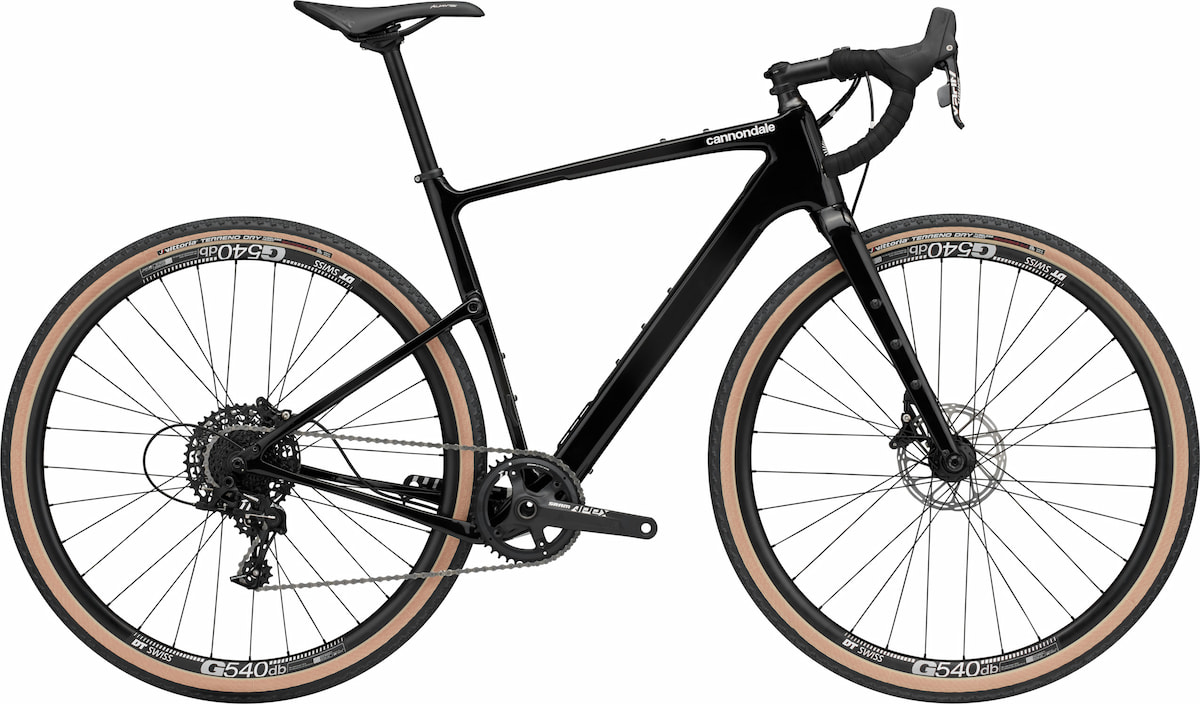
The Carbon Apex makes a departure from the trend of Shimano equipped bikes. The SRAM Apex groupset features hydraulic disc brakes and a 1x11 drivetrain, the primary advantage of which is its simplicity. One fewer cable and chainring and no front mech reduces weight and leaves fewer components to fail, for a more reliable drivetrain. SRAM shifters also only have one shift paddle each side so the brake lever does not swing inward. It makes braking that bit simpler because you don’t have to worry about accidentally shifting in the middle of a descent. There is also enhanced chain security with a single narrow-wide chainring. The sacrifices that are made in moving to a 1x drivetrain are larger gear ratio jumps and reduced gear range. However, if you’re happy to get up out of the saddle on steep climbs and coast down fast descents then this probably won’t bother you.
Other spec highlights include Vittoria Terreno Dry 38mm tyres. These are best suited (funnily enough) to dry conditions and smoother surfaces to best exploit their fast-rolling potential. These are mounted to gravel specific DT Swiss G540 rims for better aerodynamics than MTB rims. The Topstone Carbon Apex is one for those who prefer the simplicity of a 1x drivetrain and SRAM’s unique DoubleTap shifting. The stock tyres are very speed biased over grip and comfort, but this is easily changed if that’s not your preference.
This Topstone Carbon 3 is equipped with a mix of 11 speed Shimano GRX components. The shifters, cranks and brake callipers are GRX 600, while the derailleurs are top-shelf GRX 810. 11 speed delivers closer gear spacing, better shifting and longer-lasting components. Closer gear ratios help with finding a comfortable cadence no matter what speed you’re riding at. Component longevity has obvious benefits in the way of longer servicing intervals and better reliability. This is especially important if you’re heading out on multi-day bikepacking trips where component failure in a remote location could be disastrous
The tyres are the “light TCS” version of WTB’s Riddlers in the 45mm width, which are still tubeless compatible but lighter and more supple than those on the Topstone 4. It’s best to make use of the tubeless compatibility to maximise, grip comfort and rolling efficiency. This will also reduce your risk of picking up a pinch flat.
Topstone Carbon 3 650B
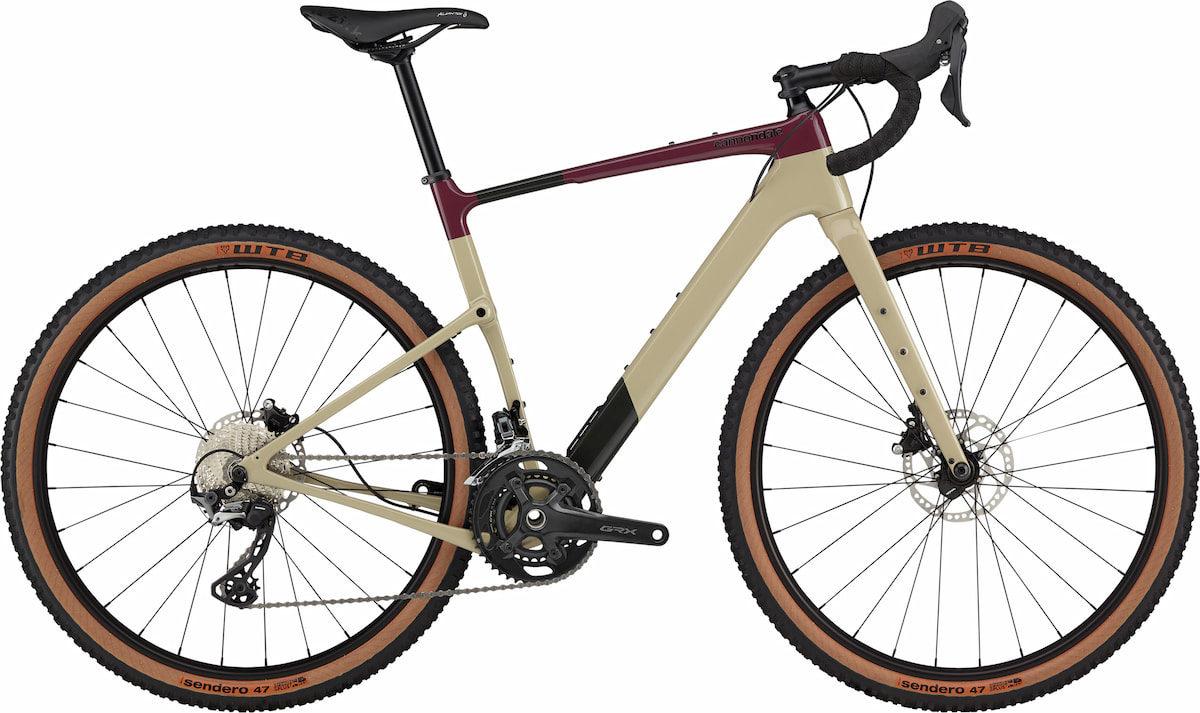
The components on the Topstone Carbon 3 650B are identical to the 700c Carbon 3 with the obvious exception of the wheels and tyres. WTB ST i25 rims and WTB Sendero TCS Light 47mm tyres behave somewhat differently to the larger wheels of every other bike in this list. The wider rubber (and wider yet can be fitted, up to 2.1”) absorbs small bumps more effectively for a smoother more comfortable ride. Chunkier tyres also grip better in corners and the lower bottom bracket further aids cornering stability. The smaller diameter wheels also turn faster for more responsive handling, which is especially handy if you have the bike loaded up with bikepacking kit. 700c wheels and tyres do roll a little bit faster and feel a little more stable at speed.
The final advantage of the smaller wheels is that you are less likely to have issues with the front tyre buzzing on your toes when turning the front wheel. This is generally only an issue for those with larger feet and/or those riding smaller frame sizes though. Whether you choose the 700 or 650 option is very much a question of personal preference based on your riding style.
Topstone Carbon 2 Lefty

The Topstone Carbon 2 Lefty is an offroad monster and a truly unique beast. The standout feature of the bike is the Lefty Oliver fork. It’s unusual to see a gravel bike with a suspension fork, let alone a one-sided suspension fork. You may be sceptical, but this technology is well proven on Cannondale’s cross country and trail mountain bikes. The Oliver is effectively a miniaturised and lightweightified (definitely a word) version of the Lefty used on these MTBs. It has 30mm of travel and the damping is fully tuneable like any other high-end suspension fork. 30mm isn’t enough to start sending cliff drops with but it makes a huge difference to the Topstone’s downhill capability and comfort. No longer will you have to dial back the speed as soon as trail gets a bit rocky. The Lefty Oliver eats up small bumps in the trail for excellent traction, speed, and comfort. Pair this with Topstone Carbon’s Kingpin suspension and you have a machine that’s almost a mountain bike… just way faster.
Back to the more conventional kit, the bike is equipped with full 1x11 GRX 810 shifting kit along with a GRX 600 crankset. This gets you a super lightweight and reliable system with excellent chain retention and crisp, precise shifting. The brakes are GRX 800 providing great braking power, feel and modulation. The seatpost is Cannondale’s own short travel (60, 80 or 100mm) DownLow dropper post. If this isn’t a statement of intent for how the bike is supposed to be used, then I don’t know what is. Having the dropper post enables you to move around more freely on the bike when descending and get properly over then back end when it gets seriously steep.
In line with the “radness” of the rest of the bike’s kit, you also get a switch to WTB’s Raddler tyres in a 44mm width. They are the Riddler’s gnarlier cousin with bigger tread blocs for better traction on loose or wet surfaces. These are, of course, tubeless compatible and come mounted on the WTB KOM Light i23 rims, for reduced rolling mass.
If you’re wanting a go-anywhere, do anything gravel bike for exploring wild places or racing the toughest courses then you can’t beat the Topstone Carbon 2 Lefty.
Electric Topstones
The Topstone Neo SLs are electric bikes that doesn’t want you to know they’re electric bikes. At least not visually but they certainly let you know in other ways. They share a lot of their DNA with the alloy Topstones. The frame is aluminium, and the fork is still carbon but it has clean legs with no cage mounts. This would have been a little superfluous given that remote bikepacking expeditions, for which fork cages are useful, rarely permit ebike charging. However, you still get the endurance geometry and dropped chainstays for comfort on long rides and stable bike handling. You still get clearance for big tyres, up to 700x47c. And you still get gravel specific componentry and more mounting points than you can shake a stick at, including pannier rack mounting bolts.
What the Neo SLs have that the analogue Topstones don’t, is electric assist. The SL (Super Light) models forgo the mid-motor and bulky battery of the standard Neo models in favour of a lower capacity, but smaller and lighter battery, paired with a 250W rear hub motor. At first glance you would think a Topstone Neo SL is an analogue bike, until you see the charge port and power button. The Mahle ebikemotion X35 system used here does sacrifices power but it comes with a host of other advantages. The most significant being its lighter weight, bringing the total bike mass down to only 14.7kg. This yields better bike handling, both on the saddle and when lifting or carrying the bike. The placement of the motor in the rear hub means a standard crankset can be fitted with a normal, more comfortable, Q-factor (lateral distance between the pedals). Another, often overlooked, benefit is that the hub motor acts against the frame to transfer power to the rear wheel instead of transmitting it through the chain. This means the drivetrain component life isn’t adversely affected by excessive loading like on mid-motor ebikes.
The whole system is operated from one central (iWOC) button on the toptube, which allows you turn the system on and off, as well as cycle through the three assistance levels. The one ring shaped light around the iWOC button indicates the battery charge level with different colours and assist level as you cycle through. The electric assist can also be turned off and you can pedal with negligible drag from the hub motor and no boost. The 250Wh battery will give you a range of up to 47mi/75km but this can be increased with a separately available range extender battery that fits in a bottle cage.
This is all well and good but why would you opt for an electric Topstone over a conventional one? They’re not multi-day bikepacking tools but they do everything else that the Topstones do, and they do it faster. You can use the assist only when you encounter steep hills if you want to or leave it on full power to complete your favourite local gravel loop in record time after work. Most of all it’s about removing barriers to riding. You don’t need to put off a ride because you’re concerned about battling a brutal headwind for half your journey. So what if the way to work is all uphill? Set max assist and cruise the commute. And who cares if your mate has bigger legs than you? Turn the tables and let them sweat a little bit. Anything that gets you out on two wheels more often must be a good thing, and that is what the Neo SLs are all about.
The Topstone Neo SL 2 is the more affordable of the two spec levels and it shares many components with the analogue Topstone 2. It also has a 2x10 speed Shimano GRX 400 drivetrain paired with GRX 600 46/30 cranks. The brakes are also Shimano GRX 400 hydraulic disc with 160mm disc rotors. Finishing kit is also provided by Cannondale and Fizik, with the exception of the seatpost, which is a Promax model.
The rims are Cannondale’s own alloy tubeless rims wrapped in 42mm WTB Resolute TCS tyres. It’s well worth converting to tubeless too, because it is very low cost and delivers a significant performance boost. The Resolutes are burlier and higher volume than the tyres on the standard Topstones, but this is more than compensated for by the electric assist, so you get more grip and comfort with none of the downsides. The clearance for 47mm tyres means you can fit mudguards with the stock tyres for a rapid winter commute or max out the clearance with even bigger tyres for even better bump smoothing and grip.
Topstone Neo SL 1
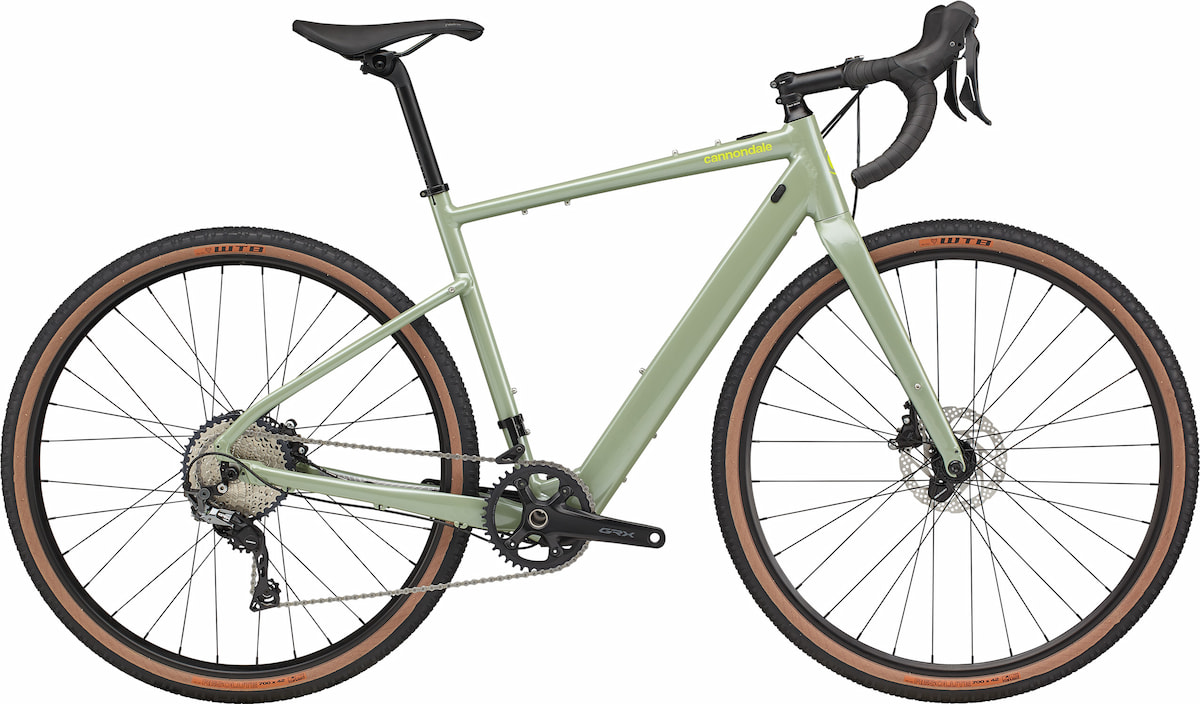
The Topstone Neo SL 1 differs from the SL 2 only in its groupset specification and frame colour. The shift/brake levers are from Shimano’s 2nd tier GRX 600 line-up. They deliver better braking power and modulation alongside crisper shifting in a lighter weight package. The drivetrain is a 1x11 setup with a 40t GRX 600 chainset and top spec GRX 812 rear derailleur. The rear cassette has an 11 to 42 for a low but not super low bottom gear. The 1x drivetrain and ratio choice makes perfect sense when considering that this is an offroad machine with pedal assist. So long as there is juice in the battery, you’re unlikely to be using the bottom gear anyway and with assistance topping out at 25km/h you won’t have any electrical help at the top end of the gear range.
All else remains equal, so the decision between SL 1 and SL 2 comes down to whether you think the weight saving and simplicity of a 1x drivetrain is worth the £300 price difference.

Check Out Alpine Bikes Here:
Alpine Bikes




